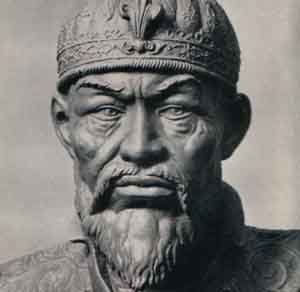The directory «Plots»
Timur, also written Emir Timur or Amir Temur (تیمور - Tēmōr, "iron"), among his other names, commonly called Tamerlane or Timur the Lame
(1336—1405)
Timur was a 14th century Turco-Mongol conqueror of much of western and Central Asia, and founder of the Timurid Empire and Timurid dynasty (1370–1405) in Central Asia, which survived until 1857 as the Mughal dynasty of India.
Timur belonged to a family of Turkicized Barlas clan of Mongol origin. He was Turkic in identity and language, and he aspired to restore the Mongol Empire. He was also steeped in Persian culture and in most of the territories which he incorporated, Persian was the primary language of administration and literary culture. Timur's short-lived empire consolidated the Turco-Persian cultural synthesis in Transoxiania: a literary form of Chaghatay Turkish was used alongside Persian as both cultural and official language.
Much of Timur's early life was spend as the leader of a robber band. At times, he was reduced to hiding in the mountains and legend has it that once after a particularly bad patch of luck, he was reduced to a single follower. Eventually, he teamed up with a local ruler and together they drove the last ruling Chaghatai prince out of power, finding a true descendent of Chinggis Khan as figurehead.
Timur was a military genius and his troops were essentially Turkic-speaking. He wielded absolute power, yet never called himself more than an emir, and eventually ruled in the name of tamed Chingizid Khans, who were little more than political prisoners. His heaviest blow was against the Mongol Golden Horde, which never recovered after his campaign against Tokhtamysh. Despite wanting to restore the Mongol Empire, Timur was more at home in a city than on a steppe as evidenced by his funding of construction in Samarkand. He thought of himself as a ghazi, but his biggest wars were against Muslim states.
He died during the campaign against the Ming Dynasty, yet records indicate that for part of his life he was a surreptitious Ming vassal, and even his son Shah Rukh visited China in 1420. He ruled over an empire that, in modern times, extends from southeastern Turkey, Syria, Iraq, Kuwait and Iran, through Central Asia encompassing part of Kazakhstan, Afghanistan, Armenia, Azerbaijan, Georgia, Turkmenistan, Uzbekistan, Kyrgyzstan, Pakistan, North-Western India, and even approaching Kashgar in China. Northern Iraq remained predominantly Assyrian Christian until the destructions of Timur.
Timur's military talents were unique. He is known to have employed what is known nowadays as information warfare. Timur's campaigns were preceded by spies whose task included collection of information and spreading of horrifying reports about cruelty, size and might of his armies - eventually weakening the morale of population and setting panic among the enemy forces.
Sources claim that when Timur conquered Persia, Iraq and Syria, the civilian population was decimated. In the city of Isfahan, he ordered the building of a pyramid of 70,000 human skulls, from those that his army had beheaded, and a pyramid of some 20,000 skulls was erected outside of Aleppo. Timur herded thousands of citizens of Damascus into the Cathedral Mosque before setting it aflame, and had 70,000 people beheaded in Tikrit, and 90,000 more in Baghdad. As many as 17 million people may have died from his conquests. Probably these numbers are inflated. Timur is historically considered to be a contradictory and controversial figure, as was the case even during his lifetime. He was a patron of the arts, but also destroyed the great centers of learning during his conquests.
Guinea, 2000, Tamerlane defeats Ottoman
Pakistan, 1997, Timur
Turkey, 1987, Tamerlane and flag of Great Timur Empire
Uzbekistan, 1996, Timur
Uzbekistan, 2001, Monument to Timur
Uzbekistan, 2001, Amir Timur order
Uzbekistan, 2002, Monument to Timur in Shahrisabz
Uzbekistan, 2002, Coins of Amir Temur
Uzbekistan, 2003, Coins of Amir Temur
Uzbekistan, 2010, Tamerlan Monument in Shakhrisabz

